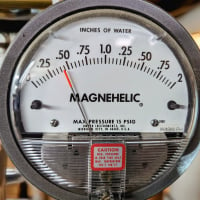Best Of
Re: Best Material to Use for Drainpipes in Residential Homes.
Just because something is easier doesn't mean it's a bad product.
I wonder how many electricians made jokes when K&T was replaced……….
We all know carpenters made fun of dimensional lumber, that's why "balloon framing" was named.
 ChrisJ
ChrisJ
How does water velocity affect a hydronic system? This weeks video
While we focus on gallons per minute and feet of head, improper water velocity in a hydronic system can cause uncomfortable areas, air accumulation, and erosion of the metal causing leaks. Hope you enjoy the video
Re: Boiler
"supposed" to be no unbreakable specs on public bid jobs like schools. They "have" to accept an = but you know how that goes.
But the boiler mfg sales reps get the engineer to spec their boiler and they do that but will accept an =. So then the boiler mfg works on the contractors to bid their boiler because it is spec and the contractor who get the bid will buy the cheapest boiler he can find that will get approved usually buying the one the engineer spec all thing being = especially the price. Burnham must have had good pricing because they took over the market around here for a long time. Probably why Smith who is 10 miles from me and had the market sewn up for 100 years is basically out of business,
Re: What was the best MacGuyver moment you actually saw on a job site?
I got 2 of them:
#1 residential oil burner and old Delco that had the oil pump internal inside the motor. The pump had quit, I had the flu and a night time service call. I went back to the shop and found an old burner on the floor. Took it back to the job. Set it on the floor and connected the oil suction line to the "new" burner and a nozzle line from the "new" burner to the existing burner. Wired the motors in parallel. Basically using the spare shop burner for a transfer pump. It fired up no leaks and I left. Put a new Beckett in the next day.
#2 Post office had replaced the boiler and HW storage tank a year ago. Christmas Eve flooded boiler room , no heat and the burner and boiler were down in a pit. Pit still full of water power on to burner and control panel lights still on!!! Killed the power and pumped water out of pit. Really cold out. Dried everything off as good as I could. Removed primary control. Put power on. Bumped motor starter and motor ran. Jumped power to ig trans and pilot gas valve and pilot lit. Put jumper wires on to burner motor starter and pilot and with pilot on jumpered to gas valve. Mod motor dead ran burner on low fire built steam and heated building for a few hours baby sitting it. Shut off power and pulled jumpers. Told them to call me if they needed heat. Old brick building held heat once it was warmed up. Returned Monday with new mod motor, ignition trans and primary control. When the plumber installed the new HW storage tank he used a BLACK plug and it blew out causing flood.
Re: Off grid heating/ac minisplit efficiency
Hi, Have you looked at the passive stuff, like white or reflective roofing, low E glass, and good shading to keep summer sun out?
Yours, Larry
Re: Off grid heating/ac minisplit efficiency
Open windows?
Depending on the heat load 1 to 3_Tons of cooling will be needed. can the solar handle that kind of start-up load?
 pecmsg
pecmsg
Re: Is the circulator pump too powerful?
wow, 5 B&G! I’d upgrade to ECM pumps and cut your power use by 90%. Gives you better control as well
 PC7060
PC7060
Re: Off grid heating/ac minisplit efficiency
Computers have switching power supplies. The first thing they do with input power is switch it on and off 100,000 times per second (roughly) because inductive and capacitive reactance increase with frequency - thus one can make them 1,666 times smaller than they need to be for 60 Hz. Then they rectify that (turn it into DC.) The input power could be DC - the wave form doesn't matter.
Re: Off grid heating/ac minisplit efficiency
Hmm, "Grundge Power"… @Jamie Hall , you might have come up with the inspired name for a band! 🙀🎶
Yours, Larry

